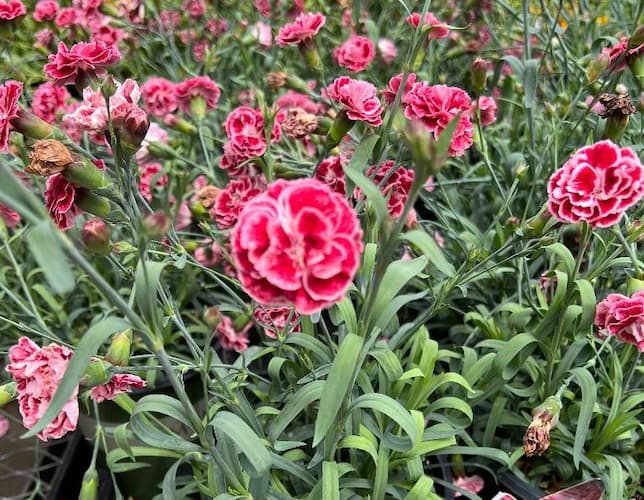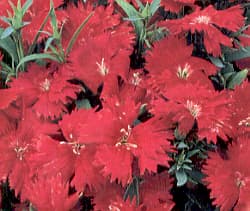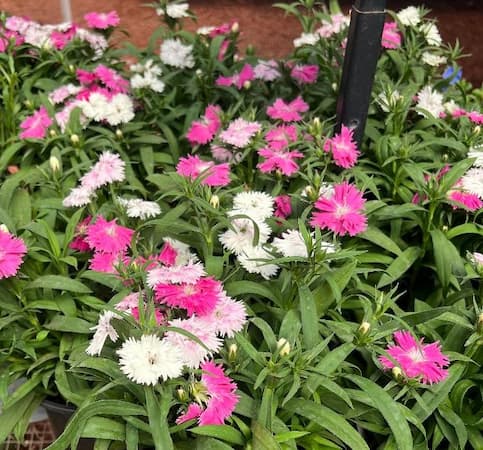How to Grow Dianthus Flowers

Growing Dianthus Perennials in Your Home Flower Garden
If you are looking for a fragrant flower, start growing Dianthus flowers. Perennial Dianthus is a hardy perennial. The flowers produce bright, fragrant blooms, and are perfect for the front of your flower bed. Learn how to grow Dianthus with this flower guide. Then, get some Dianthus seeds and get growing! You’ll be glad that you did.
Dianthus flowers have fragrant blooms, that are 1″ to 1 1/2″ diameter. They look great in a flowerbed or a rock garden. They can be planted singly or in groups. Try planting the smaller varieties in a window box. They will be right at home.
Did You Know? In Greek, Dianthus means “Divine Flower”.
Dianthus Plant Specifications
Flower Colors: Colors include pink, purple, red, white, and yellow.
Flowers Bloom: early spring to early summer.
Plant Height: Most varieties grow 18″ to 24″. However, some varieties can grow up to 3 feet.
Light Requirements: Full sunlight.
Ideal Soil pH: 6.0 – 7.5.
Hardiness Zone: 4 – 10.
Toxicity: No.
Deer Resistant? Yes. The strong fragrance of the flowers keep deer away.
Number of Species: The Dianthus family is large. There are over 300 species.
Native To: Africa, Asia, and Europe.
Plant Type: Perennials.
Botanical Name: Caryophyllaceae
Other Names: Dianthus are also known as Carnations, Sweet William, and Cottage Pinks.
Are Dianthus Flowers Edible?
YES!! They are edible for humans. It is high in vitamins Z and C. And, they contain many other nutrients. However, they are toxic pets and small animals.
The petals add color and a light, spicy flavor to drinks, salads, and desserts. The flower is an attractive garnish to dinner and dessert plates.
Note: Do not eat the base of the flower. It is bitter and does not taste good.
Medicinal Applications for Dianthus Plants
Dianthus plants have been used for thousands of years for medicinal applications. People use it as a home remedy for a wide range of maladies. Among the medical uses are:
- It has anti-microbial properties. Use it to treat infections and skin ailments.
- Use it as a treatment for bladder stones.
- The petals contain anti-inflammatory properties that reduce inflammation in the body.
- Dianthus plants aid the digestive system.
- As a diuretic, it fights urinary tract infections.
Light Requirements
Select a planting location where Dianthus plants will receive bright, full sunlight. Give them 7 to 8 hours of full sunlight.
When grown in flowerpots on a patio or deck, move the flowerpot around as needed, chasing the sun to give the plant sufficient light.
Insufficient sunlight results in fewer and less colorful flowers.
Perennial Dianthus Plant Propagation
New plants are grown from seed. They can also be propagated by cuttings.
Dianthus seeds can be directly seeded into your flower garden or started indoors for transplanting later. The plants prefer warm weather. If planting outdoors, sow them after the soil has begun to warm in the spring.
We recommend an indoor start, six to eight weeks before the last frost in your area. If started early, they will bloom in the first year.
Sow Dianthus seeds early in the season and cover lightly with soil. Space seeds or seedlings 10-12″ apart.

How to Grow Dianthus Flower Plants
Dianthus plants are very easy to grow. They prefer a cool climate and full sun.
The plants prefer rich and loose soil. To enrich the soil, add compost to the planting site. It is important for the soil to be well-draining. Stem rot can occur in prolonged wet soil.
Water the plants during dry periods, once or twice per week.
They are not big feeders. Add a general-purpose fertilizer once a month.
Mulch around the plants to provide a neat and tidy appearance. Mulch also helps to keep weeds down, and it helps to retain soil moisture.
The plants tolerate a little crowding and look good in clumps or groups.
After the flowers have died, cut the flower stems back to the main plant stem or branch.
Once your plants are established, they will grow well and bloom until frost.

Pruning Dianthus Plants
Be vigilant all season long for dead or diseased leaves and stems. Use sharp pruning shears to remove them as soon as you spot them.
As the flowers die off, deadhead the spent blooms. If the season is long enough in your area, new buds will appear.
Insects and Plant Disease
Perennial Dianthus seldom have insect and disease problems
Mildew problems may occur in warm, humid weather. If insect or disease problems occur, treat early with organic or chemical insect repellents and fungicide.
Also see: Plant Problems – Identify the causes and find the cures.
Overwintering Dianthus Flowers
dianthus plants are winter-hardy. The plants do not need winter protection in most areas.
After the first heavy frost when the plants have died off, cut them to an inch or so from the ground.
Mulching is not generally needed. however, if you are in a northerly area of the country, covering the roots with a layer of mulch will give you peace of mind during the long winter months. Early in the spring, rake excess mulch off of the roots.
Related Articles
People who read this article will also like:
How to Grow Dianthus Plants – by Garden Hobbies
Please support our site. Shop for:
- rmmatthews100@hotmail.com
- 585-721-6528
- Rochester, NY
©1999-2024 GardenersNet.Com, All Rights Reserved

